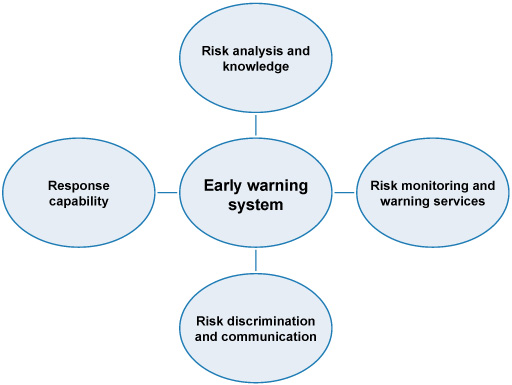12.5 Early warning systems
An important element of resilience is having contingency plans that can be put into action if disaster strikes. These are plans that provide answers to such questions as ‘what if the town floods?’ or ‘what if there’s an earthquake?’ To be effective these plans need an early warning system to alert people of impending danger to trigger avoidance actions and reduce risk. Early warning systems refer to a set of capacities needed to generate and disseminate timely and meaningful warning information to enable individuals, communities and organisations threatened by a hazard to prepare and to act appropriately and in sufficient time to reduce the possibility of harm or loss (UNISDR, 2009). Or, to put it more simply, early warning systems are designed to let people know when something bad is going to happen so they can prepare themselves and try to avoid harm. An early warning system can bring safety, security and peace of mind.
Early warning systems make contingency planning and evacuation procedures more precise and help put people and their property and livelihoods out of harm’s way. In Ethiopia there is a high degree of vulnerability to natural and climate hazards, particularly among the poorest households and those located in remote areas. Communication to these and other people through an early warning system can help reduce disaster risk by improving preparedness and giving greater protection to people and their livelihoods. Figure 12.4 demonstrates the essential elements of an early warning system.

An early warning system works best as part of an integrated and unified risk management framework. The government launched its National Policy and Strategy on Disaster Risk Management in July 2013. The main objective of the Policy is ‘to reduce disaster risks and potential damage caused by a disaster through establishing a comprehensive and coordinated disaster risk management system in the context of sustainable development’ (FDRE, 2013). Previous policies had focused on drought and are believed to have prevented severe drought disasters in 2002 and 2010. However, the government now acknowledges the risk of disasters other than drought, such as flood, human disease epidemics, livestock disease outbreaks, crop pests, and forest and bush fires. The most notable features of this new strategy have been the movement away from concentrating on drought and relief assistance to a more proactive strategy that seeks to monitor, prepare and warn people of risks both in the urban and rural areas, to decentralise the disaster risk management system and incorporate the strategy into development policies (FDRE, 2013).
With this and other policies Ethiopia is moving forward with plans to build adaptive capacity and improve resilience to climate change. We conclude this study session with a comment on the ultimate goal for resilience strategies. Whereas early notions of resilience spoke of systems returning to a stable and pre-existing state, there is now an acceptance that this is rarely possible, and perhaps not even desirable. Instead, more recent ideas have emphasised the system’s capacity to reorganise, change and adapt to threats. This is because episodes of stress can be recurrent events, and returning to the situation that existed before the disturbance may simply be a return to vulnerability. Change, however, can build greater resilience in order to be less reactive and more proactive.
12.4 Resilience in urban areas
